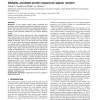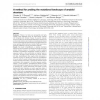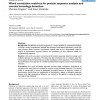220 search results - page 11 / 44 » The ASTRAL compendium for protein structure and sequence ana... |
BIOINFORMATICS
2010
13 years 7 months ago
2010
Motivation: To test whether protein folding constraints and secondary structure sequence preferences significantly reduce the space of amino acid words in proteins, we compared th...
BIOINFORMATICS
2011
12 years 11 months ago
2011
Motivation: Proteins of all kinds can self-assemble into highly ordered β-sheet aggregates known as amyloid fibrils, important both biologically and clinically. However, the spe...
CSB
2003
IEEE
14 years 23 days ago
2003
IEEE
Recognition of a protein’s fold provides valuable information about its function. While many sequence-based homology prediction methods exist, an important challenge remains: tw...
BMCBI
2008
13 years 7 months ago
2008
Background: Classification of protein sequences is a central problem in computational biology. Currently, among computational methods discriminative kernel-based approaches provid...
BMCBI
2007
13 years 7 months ago
2007
Background: We performed an exhaustive search for local structural similarities in an ensemble of non-redundant protein functional sites. With the purpose of finding new examples ...



